Seoul: April 2022
On the culinary landscape of Seoul, Mosu has quickly rised to the podium. The restaurant, helmed by the talented Sung Anh, opened only in 2017, achieved its third Michelin star in six years. With a heavy influence from Benu in California, the restaurant makes a heavy use of modernist techniques in its elaborations, transforming common Korean ingredients into surprising shapes and textures.
The man behind Mosu: Sung Anh
Born in Korea, Sung Anh embarked on his culinary journey in the contrasting milieu of a Chinese restaurant in California, run by his parents. His formative years in the United States were punctuated with a stint in the US Army, where his culinary expertise began to take shape. Despite a brief detour into the world of mechanics, Anh’s true calling as a chef eventually prevailed. Soon after cooking school he was already working at Urasawa, a Japanese restaurant in Los Angeles.
Corey Lee, another Korean-American celebrated chef, would become his lifetime mentor. He would work with him first in The French Laundry as a commis chef and chef de partie. However, Anh’s most defining role was at Benu, opened by Lee in 2010. Benu became Sung Anh’s gateway to refining his culinary style and finding his voice as a chef.
In 2015, after a stint at Aziza by Mourad Lahlou, Anh translated his vision into his first restaurant, Mosu, in San Francisco. However, the pull of his roots led him back to Korea, resulting in the relocation of Mosu to Seoul in 2017. The subsequent years saw Mosu bask in the glory of its first Michelin star in 2020, with the second and third following in 2021 and 2023, respectively.
Stepping into Mosu: a serene sanctuary of gastronomy
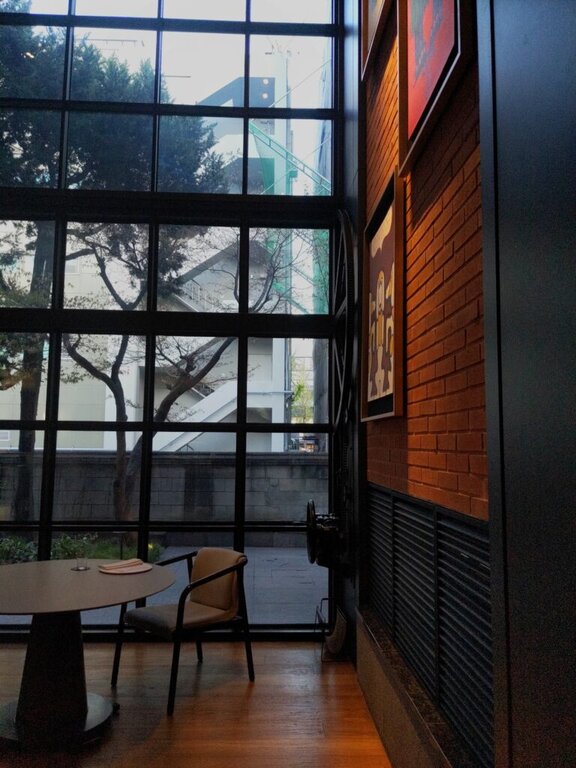
Housed in a modernistic former architect’s residence in the trendy neighbourhood of Itaewon, Mosu is marked by its spacious interiors, vast windows, and a serene garden reminiscent of Spain’s renowned El Celler de Can Roca. The distinctive calmness is amplified by the chefs’ silent service and the carefully designed noiseless pass, covered with fabric to absorb the usual clinks and clunks of a bustling kitchen. Mosu’s ambiance embodies tranquillity, focusing on a sensory experience that puts the spotlight firmly on its culinary offerings.
A striking resemblance to Benu, both in the design ethos and gastronomical approach, is evident right from the onset. A wide, circular plate, almost reminiscent of an untouched canvas, is used for serving the dishes, just like in Benu. The dish presentations and choice of crockery, as well as the typography used in the menus and logos, tie these culinary establishments together seamlessly, despite their geographical disparity.
Subtle flavors and textures: The Mosu cuisine
Mosu’s cuisine is a captivating fusion of influences from Anh’s culinary journey, elevated by his modernist techniques and appreciation for the finest ingredients. On reflecting on the overall dining experience at Mosu, the cuisine is best described as straddling the boundaries of Korean and European culinary traditions. Korean ingredients and occasional culinary concepts are interwoven into a primarily European structure. The tasting menu follows a European model with dishes echoing common features of this format: small bites (tartlets), soup-like dishes, bread, fish, beef, dessert, and petit fours. The techniques employed are decidedly European, even modernist, with dishes like tarte tatin and savoury ice creams. Mosu, therefore, can be seen as a Western-style restaurant that utilizes Korean ingredients to create a unique fusion of cultural culinary expressions.

The evening commenced with a collection of small bites, presenting us with an array of flavour profiles and textural delights. The first morsel served was a cup of crispy nori containing a filling of potato mash and sweet water prawns. This dish was decidedly minimalistic in terms of taste, highlighting Mosu’s willingness to break from tradition and focus more on texture than an overbearing flavour profile. A delicate beginning, its gentle flavours setting the stage for the culinary narrative to follow.

A fresh salad followed, showcasing a variety of Korean spring greens known as namul, neatly assembled on a crunchy rice cracker. The greens gave off different flavours, making each bite exciting and unique.

Next, we savoured a Deodeok tartlet, an all-Deodeok affair. Deodeok, a Korean root vegetable, was employed in the making of the tartlet shell, béarnaise, and the garnishing. Despite the intensive use of this one ingredient, the overall flavour was curiously reminiscent of a cheese and puff pastry snack, an unexpected taste memory that speaks volumes about the transformative nature of the culinary arts.
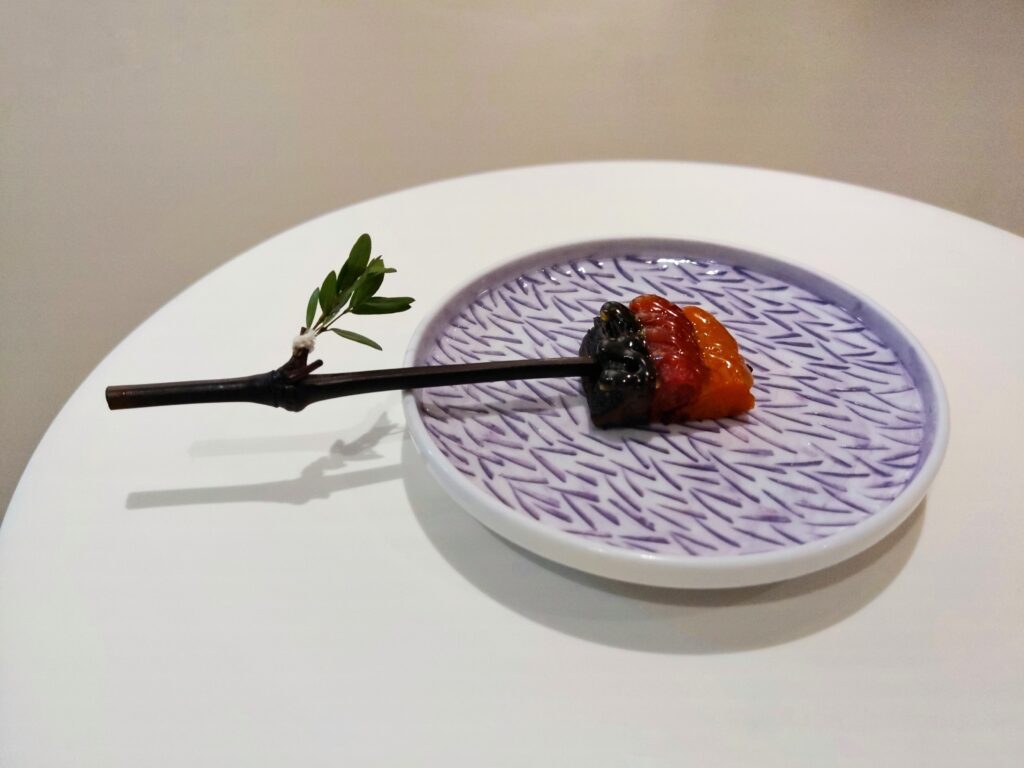
Following this, a brochette of semi-dehydrated vegetables, namely carrot, tomato, and aubergine, arrived. Topped with olive oil jam, this dish illustrated a Spanish influence on Mosu’s cooking. An exemplar of modernist cuisine, the dish highlighted similar textures despite the different ingredients used. By concentrating the flavours and adjusting the textures, Mosu demonstrated the magic of thoughtful culinary technique. The aesthetic of this dish is evocative of Benu’s influence, particularly evident in the alternating colours of the vegetables.

The final small bite in this series was a Hanwoo beef tartlet, an indulgent bite showcasing both Hanwoo beef tartare and bresaola. Encased in a squid ink tartlet, this morsel exuded a robust beef flavour, deftly counterbalanced by the smoky bresaola. The harmonious interplay of textures made it an impressive closing note to this part of the menu.
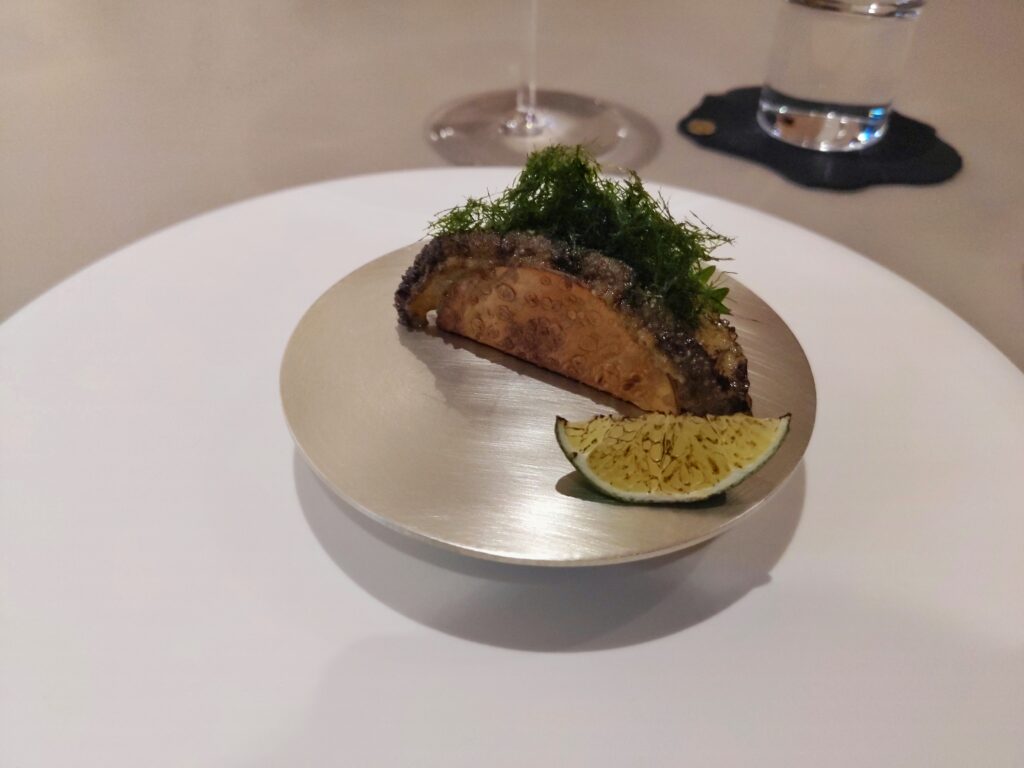
The main portion of the tasting menu commenced with a playful take on the classic fish taco, showcasing Mosu’s willingness to fuse global culinary concepts with a Korean touch. Here, the taco shell was replaced by a thin, brittle Yuba tortilla, its lack of significant flavour allowing the other ingredients to shine. The star of the dish was the grilled abalone, cooked slowly until tender, giving off a delicate smoky flavour. However, compared to its use in Sushi Mai, the abalone flavour felt underrepresented in this dish. Accompanied by perilla leaves, fried gamtae, and grilled lime, this starter successfully established a nuanced and balanced flavour palette, with the perilla leaf being the dominant flavour.
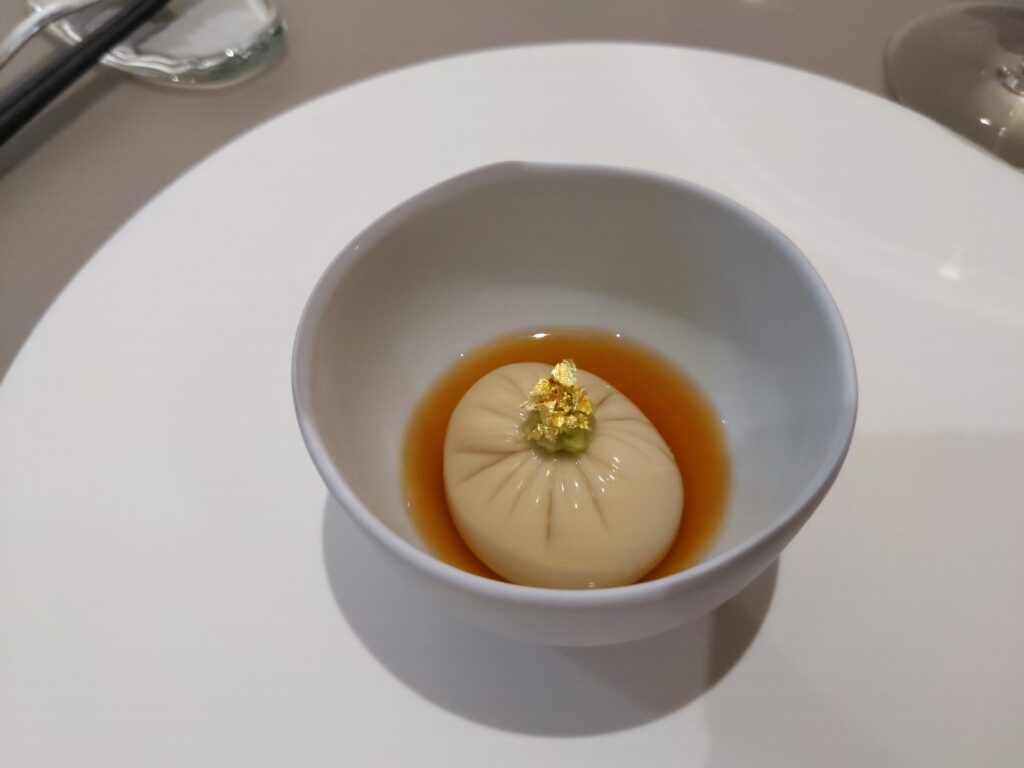
The procession continues with the next starter – an innovative rendition of a dumpling. Here, Mosu pays tribute to traditional cuisine while pushing boundaries. Discarding the typical dough casing, the dumpling shell is instead formed from toasted sesame tofu. Upon it, a texture reminiscent of mozzarella gently rests, providing a nuanced balance of flavours. Inside, a treasure of uni awaits. However, the ratio of tofu to uni was skewed heavily towards the former, a factor that curtailed the full experience of this inventive creation. The dish was rounded off with a dash of wasabi and gold flakes, and served with a delightful kombu anchovy broth.
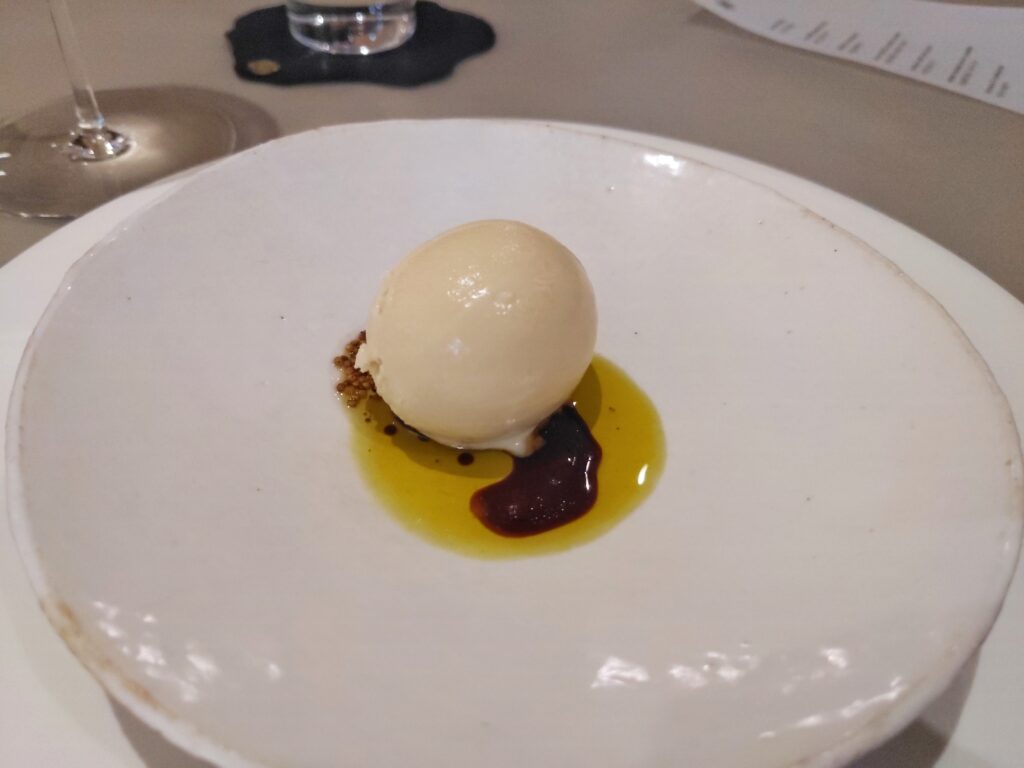
We were then presented with the bread course, a playful twist on tradition. Mosu subverted expectations with a scoop of toasted sourdough ice cream, bathed in fruity olive oil, a drizzle of balsamic vinegar and some puffed quinoa. This creative take, reminiscent of Spanish deconstruction, reimagines the ubiquitous bread-and-butter pair in a gastronomically enlightening way. Although the texture of the ice cream may not have been flawless, the flavours and concept were impressively realized.

The ensuing dish was steamed tile fish, locally referred to as ‘amadai’, served with three distinct sauces. The steaming process ensured the flesh retained its juicy consistency, while the skin offered a gelatinous contrast. The presentation and flavour profile of this dish, featuring sauces of steamed brassicas, mustard, and a pink brassicas variant, mirror the culinary influence from Benu. The amalgamation of the sauces and the fish was commendable – simple yet extraordinary, and one of the finest fish dishes I’ve encountered in Korea.

This was followed by a caviar dish, presented in a way that elevated the inherent elegance of caviar. The seasonal Korean snow crab was adorned with pickled red onions and toasted bread crumbs, crowned with a mousse of lily and caviar. This dish was an exemplary marriage of ingredients, balancing seasonal tastes, textures, and refinement. It was, in essence, the quintessential Mosu dish.


Our journey continued with a burdock tarte tatin. This dessert was strikingly similar to a dish from Sollip, a Korean restaurant in London. The pastry was a delightful play of buttery and flaky textures – a rarity in Korea due to the differing quality of butter. Topped with shredded caramelized burdock, the vegetable imparted a distinct coffee-like aroma. Served with a watery burdock skin broth, this tarte tatin was a celebration of burdock, although a touch too burnt at the top.

Our next stop was the pasta course, featuring acorn noodles in truffle butter sauce. The dish, while undeniably indulgent, was an odd inclusion considering the season. The quality of the truffles, being off-season Australian variants, was slightly underwhelming. The noodles, however, had a deep, nutty flavour and the butter used was of notable quality.

The last savoury dish of the tasting menu paid homage to the Korean preference for red meat. The featured Hanwoo beef, similar to Wagyu, showcased thick strands of inter-muscular fat, yielding a texture that may seem too soft for some palates. As is the norm in Korea, the beef is not aged, resulting in a flavour profile closer to veal than to beef. The beef was accompanied by a beef glaze, dureup (a Korean spring green with a fennel-like flavour), and a side of mulberry jam. A fitting end to the savoury courses, the beef dish encapsulated the uniqueness of Korean cuisine, before we embarked on the dessert segment.

As we moved into the dessert course, our palates were first greeted with a delightful jasmine sorbet. A spritz of lime elevated this classic palate cleanser, the citrusy freshness preparing us for the sweet journey ahead.

Borrowing from the French tradition of petits fours, the chef introduced a series of small sweet treats before the main dessert. The first of these was a mould-inoculated mochi, akin to a creation we previously encountered at Mugaritz. Koji, a mould used in the production of sake, provided a layer of fine, hair-like texture to the rice cake, making it an intriguing, albeit subtly flavoured, offering.

Next was a choux pastry, filled with a creme pâtissière enhanced by caramelized kombu. The creme pâtissière hinted at the flavour of salted caramel, made more complex by the savoury undertones of the roasted kombu, which develops a smoky, coffee-like aroma when cooked. This particular sweet bite was perhaps the star of Mosu’s dessert line-up, masterfully balancing the boldness of the roasted kombu with the rich creaminess of the filling.

Then came the main dessert course: an innovative onion dessert. Comprising onion ice cream and kibbled onion powder, with a sprinkle of coffee powder, this dessert was a testament to Mosu’s innovative approach to gastronomy. The caramelized onion ice cream managed to be both sweet and savoury, the kibbled onions adding a textural element that elevated the dish further. It was an unexpected delight, though the ice cream texture left some room for improvement.

The final offering was a small honey cake called ‘yakwa‘, a deep-fried pastry steeped in honey syrup. Regrettably, this was the least successful dessert, as the oil used in frying was rather overpowering, diminishing the inherent sweetness of the yakwa.